Rublev vs Draper: Doha Final Recap
acceptance — reactive brakes — fist grips versus trigger grips — return positions — backhands —
Andrey Rublev clinched his second ATP Doha title on Sunday (2020), defeating Jack Draper 7/5 5/7 6/1. It was the Russian’s 17th title overall. Rublev extends his perfect record against Draper to 4-0.
Rublev is reportedly using a lighter racquet this season, perhaps in a bid to aid his super-aggressive court position, but it was the Russian’s mental approach that has been the biggest self-confessed improvement in his game recently.
It was this time last year, during the Dubai ATP 500, that Rublev was defaulted from his semifinal match against Alexander Bublik. Long known for his hot temper, Rublev laid bare the mental struggles he had been going through later in the year. From tennis.com:
“Mentally I was out of order,” he admitted. “I guess it was already a long moment of everything (building up) and I started to burn out, because I was struggling for many years with depression, with many things outside of the court… I guess this year it’s when I can’t handle it anymore, and it starts to just explode...“It started to explode more and more on the court, because in life I was able to stay calm but inside the court I was burning everything.”
Rublev made changes. The antidepressants were flushed. Marat Safin (who knows a thing or two about on-court meltdowns) was consulted. Rublev began working with a psychologist.
I don’t mean to speculate as to what Rublev has been working through with his psychologist, but his language around acceptance is interesting:
“You can have everything in life—a healthy family, all the material things—but if there’s something going on inside you that you don’t see, you’ll never be happy. You have to find it, accept it, and you’ll start feeling better and better,” he explained.
I wrote a piece on competence, confidence, and Acceptance and Commitment approaches several years ago that echoed similar themes, albeit more focused on sports performance. Whatever his approach, Rublev seems to be making strides in an area of his game that has always been brittle:
"I was really good mentally and didn't let frustration get over me," Rublev said. "As soon as I was frustrated, I was able to restart again and I was able to play at the same intensity. That's the most important thing."
Intensity is a good word to describe Rublev’s game. His matchstick physique conceals a compact forehand that can ignite from anywhere, and I can’t say I’ve often seen the Russian shy away from accelerating into contact. He has an interesting grip — what I would call a fist grip — where the index knuckle is something of an extreme semi-western, but the heel pad straddles something closer to an extreme eastern and a mild semi-western to my eye. You see something similar in Tsitsipas and Djokovic, and this often forces the fingers closer together:






Some coaches think such a fist grip is sub-optimal, but my observations and experimentation has me thinking it may actually facilitate lag and flip to the inside of the ball off a compact setup.
Apart from the grip, Rublev’s follow-through is also a little unique in that he doesn’t really have a windshield wiper finish. He keeps his palm up and doesn’t pronate the elbow in the follow through until much later. Compare to Sinner:

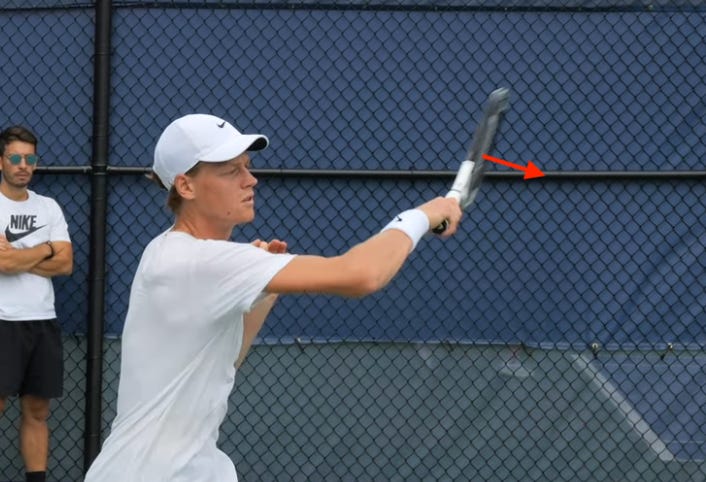
More to come in Death of a Forehand - Part IV.1
Grip peculiarities aside, Rublev is also an excellent exponent of the three left side reactive brakes: the head, the left arm, and the left leg.
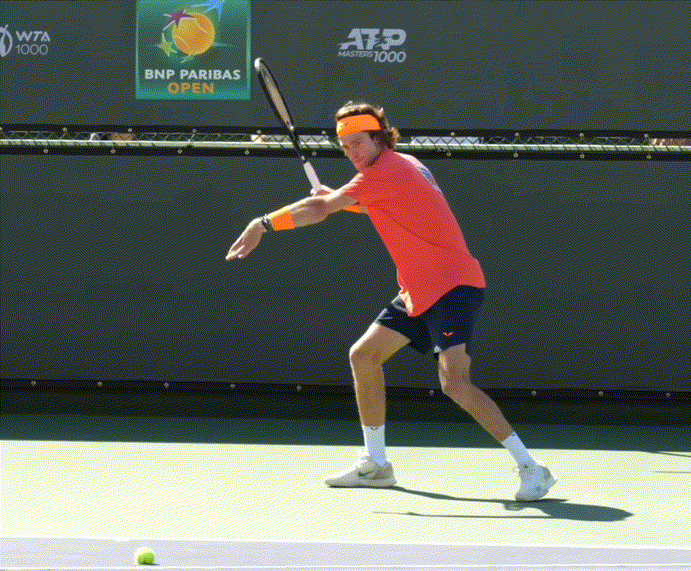
It’s a compact and trusty weapon that has payed for plenty of bills in the Russian’s career.
But I digress. It was the forehand of Draper that was hot early on, the Brit threading a nice line forehand away from Rublev here:
It’s a shot that has undergone a pretty radical technical change since his junior days:
Coupled with his athleticism, Draper has quietly developed the forehand into something of a weapon, seen here showcasing his end-range ability on a poor volley from Rublev.

Here’s an example from early in the second of how Rublev adjusts and goes behind Draper with the volley. You can see how the Brit was anticipating a short volley into the open space again:

Both men held easily without needing a deuce until Draper threw in a loose game at 5-7 to gift Rublev the first set. Rublev on first serves was especially dominant, going 17/18, but he also went 7/9 on second serve points.
I felt Draper could have played more aggressively on second-serve returns against Rublev, who owns a slow second serve courtesy of his grip not quite being continental, thus making it difficult to accelerate with spin (I think Murray had a similar issue). Draper’s backhand is world-class at taking the ball early and directing it flat and hard. Here’s an example from in a rally:

And here’s an example of just how slow and short Rublev’s second-serve was often landing (129km/h on this occasion). Draper opts to take his backhand off this from a metre or so behind the baseline (instead of running around for a forehand) into Rublev’s forehand, and it just doesn’t bother Rublev enough:
When returning from deep Draper looked much more dangerous when doing so from his forehand, as he did on the very next point:
Part of this is often court position; Draper wants to hit the shot that will allow him to recover closer to centre more easily, but I still think he could have applied more pressure with his position and mixed in the early return, or looked for more forehands when returning deep on second serves.
On the other hand, Rublev is always looking to take time away on return. Gill Gross calls it ‘casino returning’, where the Russian essentially guesses on first-serve returns more often in a bid to hold a position closer to the baseline. It had some unintended effectiveness early in the second, where Rublev ended up guessing on the wide backhand, changing to his backhand grip, and then being forced to chip return the forehand:
Here it is slowed down. You can see Rublev start in his forehand grip, and then change to backhand as he split steps forward, just before Draper has struck the serve.
Rublev would earn two break chances off a couple of chips (one in a rally), but then he opted to return Draper’s second-serve at 15-40 from deep behind the baseline (not his M.O.), his backhand weakly landing halfway up the net:
Draper would snuff out the next one with an unreturned first serve; a shot the Tennis TV commentary said he was refining with a baseball pitching coach in the off-season.
But back to Rublev’s backhand for a moment…I’ve touched on the Russian’s backhand deficiencies before, noting that it lacks either the length in the backswing of someone like Sinner, or the locked-wrist extension of someone like Alcaraz, to be a truly world-class backhand. Compare the length of backswing with Sinner:

Alcaraz is another who can excel playing his backhand from deep returns despite a similar compact setup like Rublev. But the Spaniard has incredible extension in his follow through, seen here dropping the left hand once the racquet gets too far away on this mis-timed return:
You just don’t notice it because the Spaniard finishes his swing around his shoulder once the racquet comes down from that height. The difference in follow through is often noted by the racquet angle:

This is where technique just makes it harder to execute certain tactics, and why I call some players ‘tactically inflexible’; they may know what they need to do, or they may want to do a certain shot, but their technique flaws make that exceedingly difficult. Rublev again dropped the Ad-in point with a weak return from deep he wasn’t particularly proud of:
In the next game it’s the first instance where I see Draper step in on the Rublev second serve. You can see in the prep here how Rublev’s grip straddles the eastern bevel with his index knuckle, meaning he can hit flat serves fine, but he struggles to confidently execute aggressive kick serves.
Draper made more inroads on return in set two, winning over 35% of points, but it wasn’t until 5-5 when Draper’s level really elevated off the ground, peppering the Rublev forehand with pace and stealing ground for multiple points:
Draper would break for 6-5 and promptly serve it out to force a third set. Look how aggressive he is with the forehand line again to set the tone for this service game, then jumps on the short backhand:
But as quickly as Draper’s level rose at the backend of the second, it dropped at the start of the third. The Brit had logged nearly five hours on court in the last two days, and while fitness has been a priority of his in the last 12 months, this was another data point to suggest there is still some question marks over that part of his game. The movement and racquetwork looked sloppy at end range, and Rublev remained steady, letting Draper’s errors do the work for him. On his first break chance at 1-0, Rublev’s roulette return strategy paid off, guessing wide and passing Draper’s serve-and-volley attempt:
Rublev earned another look for the insurance break at 3-0 and again played up in the court on the second-serve return, where his backhand is suited:
The Russian converted with an ace on his first match point in what was a quick and underwhelming third set, but nevertheless a promising win for Rublev, who hadn’t won a title in 10 months.
Has he turned a corner mentally? I don’t think an ATP 500 is where we find that answer. He’s got a bagful of these type of event/final opponent wins already in his career. I’m looking forward to finding out soon, though, and hope he can deliver.
Rublev:
“It feels amazing,” said Rublev. “It’s my first ever title that I won twice.. I’m really happy. I think both of us were really tired after two three-set matches that finished late. We were exhausted and it was difficult, but somehow we were able to play at a good level. When I lost the second set, I let it go and started to play more freely.
Draper:
“It’s been an amazing week,” said Draper. “Andrey was too good today. We played some tough matches this week and in the third set he was just a bit too strong for me. I’m really proud of my efforts this week. Every day, I wake up and try to improve, so it’s a testament to my hard work I suppose.”
I’ll be back after Dubai/Acapulco/Santiago. See you in the comments. HC.
Some notable trigger grip forehands: Dimitrov, Federer, del Potro, Berrettini, Medvedev, Kyrgios. Fist grip forehands (to some extent): Rublev, Tsitsipas, Djokovic, Shelton, Musetti, Shang.





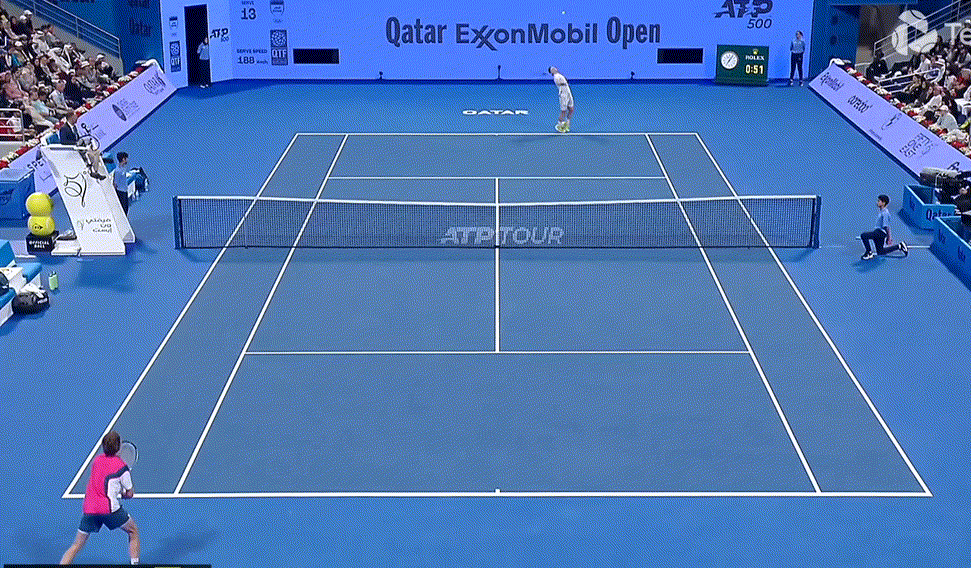





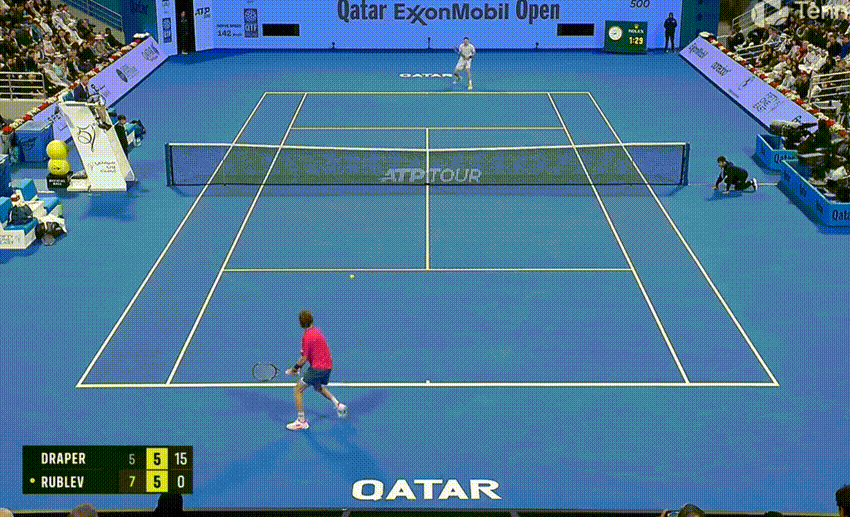


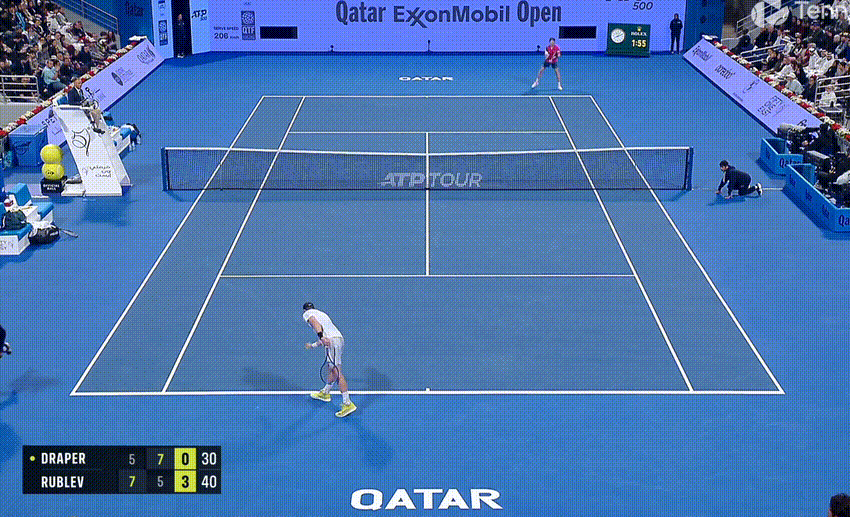
Not a lot of commentary out there on Rublev's fitness. The guy plays among the most matches every year for a top 10 player and he rarely breaks down. The simplicity of his game helps...when tired he's not forced to make difficult shot choices...his game is his game. I made this comment last year in jest, but I kind of think Draper needs to move to a hot climate and train year-round.
I’d often thought that Rublev’s serving grip wasn’t quite Continental - good to have confirmation.
His serve mechanics though are lovely: no hitches or pauses, and the racket hand is so close to the head - which I think(?) is a source of consistency; I look at Cerundolo, whose racket hand is miles away from his head at the point where it accelerates and think it must be hard to do that precisely again and again. (Maybe one for a future Death of a Serve? 😬)
We get fh and bh rpms but never serve rpm - that would be really interesting for slice and topspin serves. Does Hawkeye not collect it?